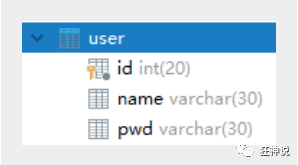1、数据库中的各字段名

2、JavaBean中的类
密码和数据库不一样!
public class User { private int id; //id private String name; //姓名 private String password; //密码和数据库不一样! //构造 //set/get //toString() }
3、Mapper接口
//根据id查询用户 User selectUserById(int id);
4、Mapper.xml
<select id="selectUserById" resultType="user"> select * from user where id = #{id} </select>
5、Test测试
@Test public void testSelectUserById() { SqlSession session = MybatisUtils.getSession(); //获取SqlSession连接 UserMapper mapper = session.getMapper(UserMapper.class); User user = mapper.selectUserById(1); System.out.println(user); session.close(); }
结果:
User{id=1, name=‘王萍‘, password=‘null‘}
查询出来发现 password 为空 . 说明出现了问题!
分析:
select * from user where id = #{id} 可以看做
select id,name,pwd from user where id = #{id}
mybatis会根据这些查询的列名(会将列名转化为小写,数据库不区分大小写) , 去对应的实体类中查找相应列名的set方法设值 , 由于找不到setPwd() , 所以password返回null ; 【自动映射】
解决方案
1、在sql语句中添加别名 AS
<select id="selectUserById" resultType="User"> select id , name , pwd as password from user where id = #{id} </select>
2、resultMap 结果集映射
<resultMap id="UserMap" type="User"> <!-- id为主键 --> <id column="id" property="id"/> <!-- column是数据库表的列名 , property是对应实体类的属性名 --> <result column="name" property="name"/> <result column="pwd" property="password"/> </resultMap> <select id="selectUserById" resultMap="UserMap"> select id , name , pwd from user where id = #{id} </select>
自动映射
resultMap 元素是 MyBatis 中最重要最强大的元素。它可以让你从 90% 的 JDBC ResultSets 数据提取代码中解放出来。
实际上,在为一些比如连接的复杂语句编写映射代码的时候,一份 resultMap 能够代替实现同等功能的长达数千行的代码。
ResultMap 的设计思想是,对于简单的语句根本不需要配置显式的结果映射,而对于复杂一点的语句只需要描述它们的关系就行了。
你已经见过简单映射语句的示例了,但并没有显式指定 resultMap。比如:
这是因为数据库中的字段名和Java的属性名称相同,自动映射
<select id="selectUserById" resultType="map"> select id , name , pwd from user where id = #{id} </select>
上述语句只是简单地将所有的列映射到 HashMap 的键上,这由 resultType 属性指定。虽然在大部分情况下都够用,但是 HashMap 不是一个很好的模型。你的程序更可能会使用 JavaBean 或 POJO(Plain Old Java Objects,普通老式 Java 对象)作为模型。
ResultMap 最优秀的地方在于,虽然你已经对它相当了解了,但是根本就不需要显式地用到他们。
手动映射
1、返回值类型为resultMap
<select id="selectUserById" resultMap="UserMap"> select id , name , pwd from user where id = #{id} </select>
2、编写resultMap,实现手动映射!
<resultMap id="UserMap" type="User"> <!-- id为主键 --> <id column="id" property="id"/> <!-- column是数据库表的列名 , property是对应实体类的属性名 --> <result column="name" property="name"/> <result column="pwd" property="password"/> </resultMap>
在学习mybatis等持久层框架的时候,会经常对数据进行增删改查操作,使用最多的是对数据库进行查询操作,如果查询大量数据的时候,我们往往使用分页进行查询,也就是每次处理小部分数据,这样对数据库压力就在可控范围内。
sql语句实现方法
#语法 SELECT * FROM table LIMIT stratIndex,pageSize SELECT * FROM table LIMIT 5,10; // 检索记录行 6-15 #为了检索从某一个偏移量到记录集的结束所有的记录行,可以指定第二个参数为 -1: SELECT * FROM table LIMIT 95,-1; // 检索记录行 96-last. #如果只给定一个参数,它表示返回最大的记录行数目: SELECT * FROM table LIMIT 5; //检索前 5 个记录行 #换句话说,LIMIT n 等价于 LIMIT 0,n。
步骤:
1、修改Mapper文件
<select id="selectUser" parameterType="map" resultType="user"> select * from user limit #{startIndex},#{pageSize} </select>
2、Mapper接口,参数为map
//选择全部用户实现分页 List<User> selectUser(Map<String,Integer> map);
3、在测试类中传入参数测试
推断:起始位置 = (当前页面 - 1 ) * 页面大小
//分页查询 , 两个参数startIndex , pageSize @Test public void testSelectUser() { SqlSession session = MybatisUtils.getSession(); UserMapper mapper = session.getMapper(UserMapper.class); int currentPage = 1; //第几页 int pageSize = 2; //每页显示几个 Map<String,Integer> map = new HashMap<String,Integer>(); map.put("startIndex",(currentPage-1)*pageSize); map.put("pageSize",pageSize); List<User> users = mapper.selectUser(map); for (User user: users){ System.out.println(user); } session.close(); }
我们除了使用Limit在SQL层面实现分页,也可以使用RowBounds在Java代码层面实现分页,当然此种方式作为了解即可。我们来看下如何实现的!
1、mapper接口
//选择全部用户RowBounds实现分页 List<User> getUserByRowBounds();
2、mapper.xml
<select id="getUserByRowBounds" resultType="user"> select * from user </select>
3、Test代码
@Test public void testUserByRowBounds() { SqlSession session = MybatisUtils.getSession(); int currentPage = 2; //起始页 int pageSize = 2; //每页显示几个 RowBounds rowBounds = new RowBounds((currentPage-1)*pageSize,pageSize); //通过session.**方法进行传递rowBounds,[此种方式现在已经不推荐使用了] List<User> users = session.selectList("com.dao.UserMapper.getUserByRowBounds", null, rowBounds); for (User user: users){ System.out.println(user); } session.close(); }
原文:https://www.cnblogs.com/yyyyff/p/14757730.html